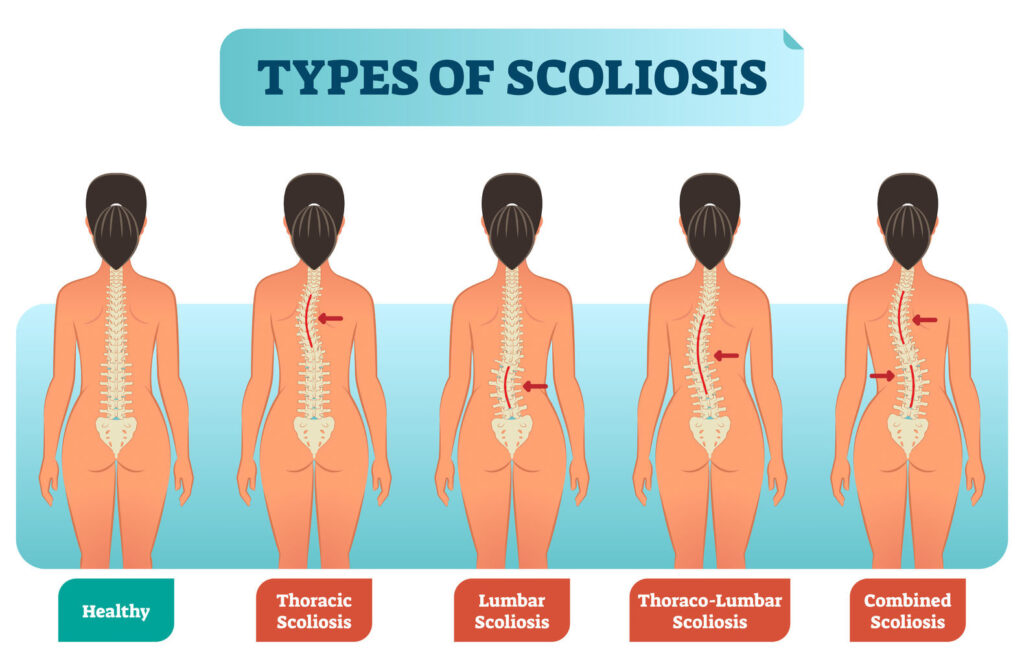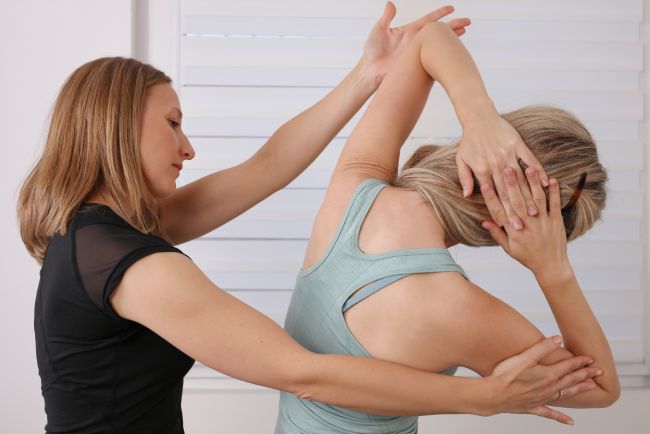Definition of Scoliosis
Scoliosis is a condition characterised by an abnormal lateral curvature of the spine, which can affect posture, mobility, and comfort. It is typically diagnosed through physical examination or observation of spinal alignment, though its cause often remains unclear. Symptoms may include uneven shoulders, hips, or waist, back pain, or stiffness. Untreated scoliosis can impact the spine, chest, heart, and lungs, potentially leading to complications. At Elite Performance Therapy, we provide specialised sports therapy following an initial consultation to alleviate discomfort, enhance spinal function, and improve quality of life.

Causes of Scoliosis
Scoliosis may arise from various factors, with idiopathic scoliosis (of unknown cause) being common. Key causes include neuromuscular disorders (e.g., cerebral palsy), leg length discrepancies, rapid adolescent growth spurts, congenital spinal abnormalities, injuries, or degenerative conditions like arthritis. Symptoms may develop gradually or after a specific event, and neglecting them can worsen curvature and health outcomes.
Initial Management Strategies
Early intervention can help manage scoliosis symptoms and prevent progression. Recommended steps include:
- Postural Awareness: Maintain a neutral spine position to reduce strain.
- Gentle Movement: Engage in low-impact activities like walking to preserve mobility.
- Heat Therapy: Apply heat packs for 15 minutes to ease muscle tightness.
Treatment Approaches
Here at Elite Performance Therapy we offer sports therapy to address scoliosis, focusing on pain relief, spinal mobility, and functional improvement. Treatments are always tailored to each client but may include:
- Sports Massage: This reduces muscle tension, alleviates pain, and enhances circulation, promoting flexibility in back muscles affected by scoliosis.
- Trigger Point Therapy: Targeted techniques address muscle tightness, providing immediate pain relief and improved movement.
- Deep Muscle Therapy: Deeper massage relieves chronic back pain and stiffness, supporting muscle recovery.
- Dry Needling: Fine needles inserted into trigger points release tension, reduce pain, and improve blood flow, easing scoliosis-related discomfort.
- Proprioceptive Neuromuscular Facilitation (PNF) Stretching: PNF stretching enhances spinal flexibility and muscle strength, improving posture and range of motion.
- Rehabilitation Exercises: Personalised exercises are critical for scoliosis management, designed to increase spinal mobility, reduce stiffness, and strengthen supporting muscles. Specific exercises include:
- Cat-Cow Stretch: Performed on all fours, this yoga-inspired stretch involves alternating between arching (cow) and rounding (cat) the back, mobilising the spine and relieving tension. It enhances flexibility and is gentle enough for daily practice, often providing immediate relief.
- Side Plank (Modified): A modified side plank, performed with knees bent or supported, strengthens the oblique muscles on the convex side of the curve, promoting spinal stability. Patients hold the position for 10–20 seconds per side, gradually increasing duration to build endurance.
- Seated Spinal Rotation: Sitting with legs crossed, patients rotate the torso gently towards one side, holding for 15 seconds, to improve thoracic mobility and reduce stiffness. This is performed on both sides to balance flexibility.
- Schroth-Inspired Exercises: Adapted from the Schroth method, these involve specific postures (e.g., side-lying on a rolled towel) to elongate the spine and correct curvature, guided by therapists to target individual curve patterns.
- Pelvic Tilts: Lying on the back with knees bent, patients tilt the pelvis to flatten the lower back against the floor, strengthening core muscles and supporting spinal alignment. This is repeated 10–15 times per session.
- PNF Contract-Relax Stretch for Hamstrings: Patients contract the hamstrings against resistance (e.g., a therapist’s hand) for 6 seconds, then relax into a deeper stretch, improving lower back and pelvic flexibility, which supports spinal health.
These exercises, often effective from the first session, are progressed based on patient response, ensuring pain-free movement and long-term benefits. Chiropractic care or osteopathy, including spinal manipulation, may be incorporated where appropriate to enhance alignment.

Preventing Progression
Preventing scoliosis progression involves habits to support spinal health:
- Regular Exercise: Back and core exercises enhance stability and posture.
- Postural Correction: Maintain correct posture to minimise spinal strain.
- Ergonomic Adjustments: Is your desk setup supporting your spinal alignment?
- Ongoing Monitoring: Consider regular therapy check-ins to keep on top of your spinal health.
Are you struggling to manage your scoliosis ? Here at Elite Performance Therapy we are here to help! Excited to learn more or start with a free initial chat? 😊
Get in touch to book your appointment and start your path to a more comfortable back.
What our clients say:
“I’ve never tried anything like these treatments – and I can highly recommend Isy / Elite Performance Therapy!! I have a mild scoliosis in my back, but Isy managed to make my chronical pain almost disappear! I’m thrilled!
J Nielsen
I play football and got it to recommend through a teammate! And then she is an absolute darling!
Top performance!! Xx”
